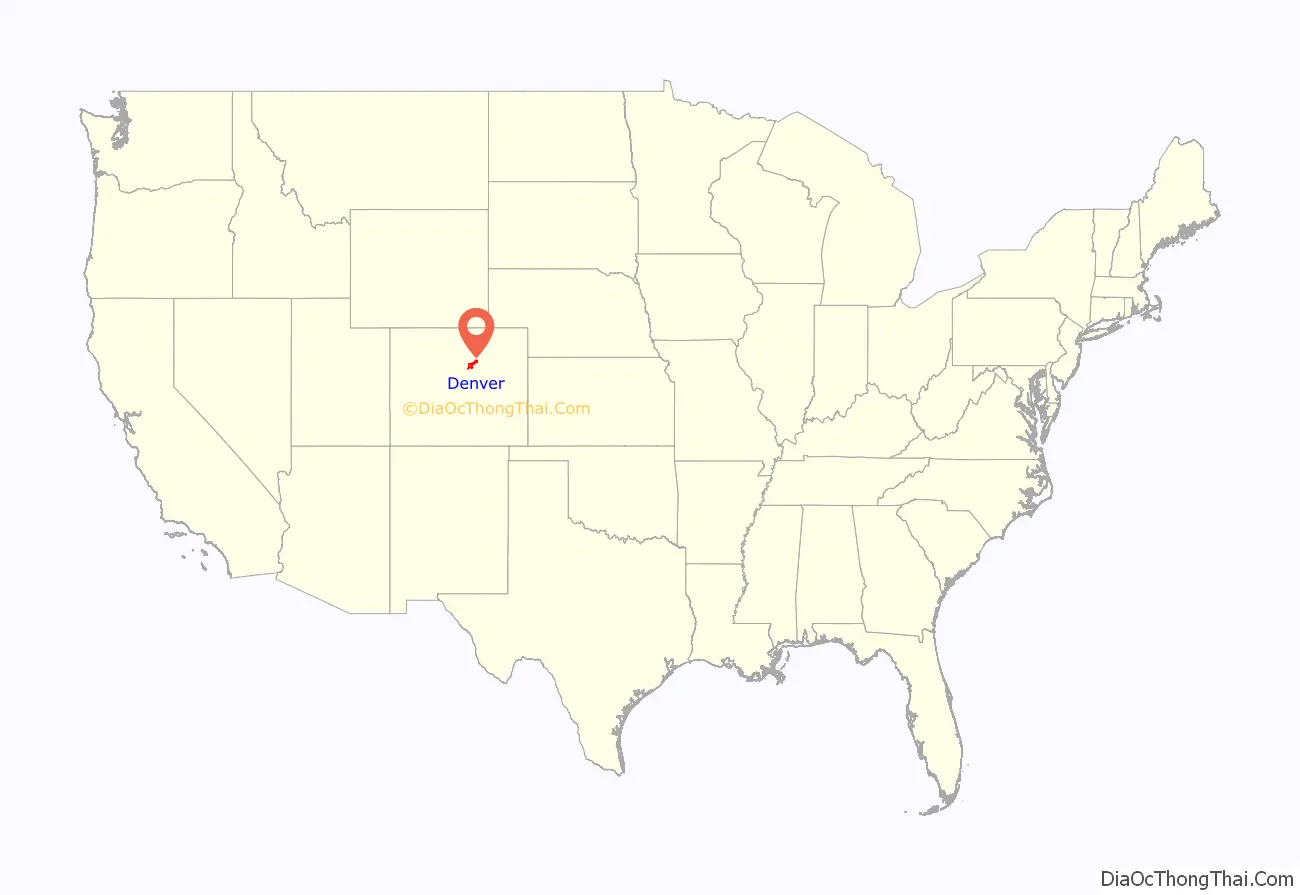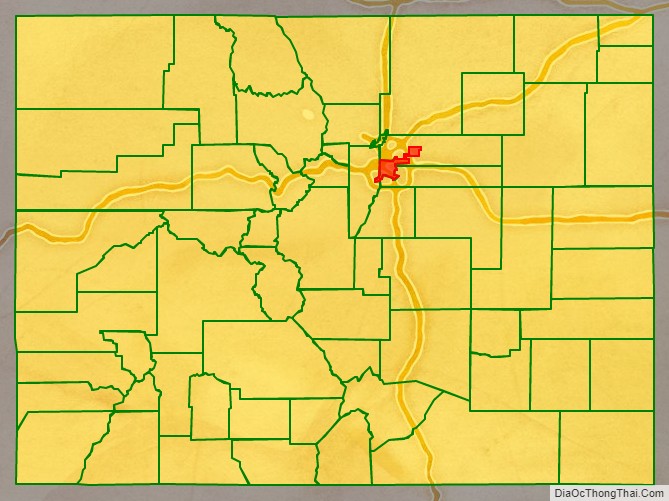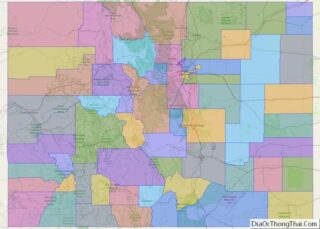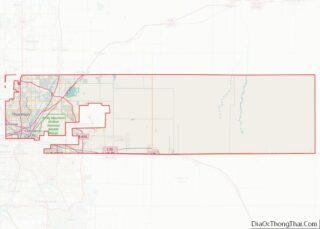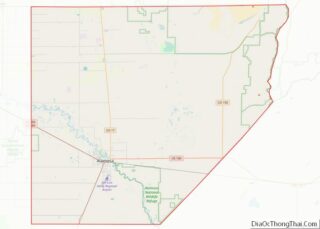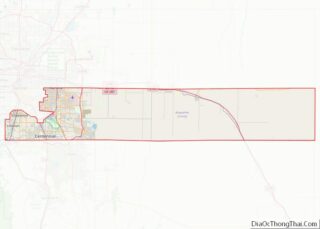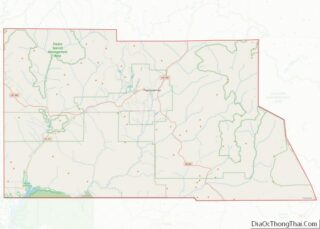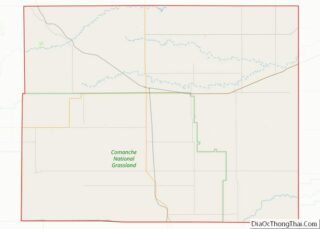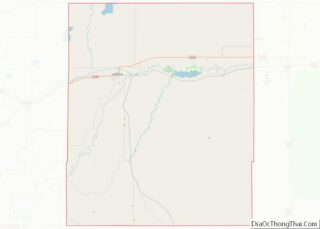Denver (/ˈdɛnvər/) is a consolidated city and county, the capital, and most populous city of the U.S. state of Colorado. Its population was 715,522 at the 2020 census, a 19.22% increase since 2010. It is the 19th-most populous city in the United States and the fifth most populous state capital. It is the principal city of the Denver–Aurora–Lakewood, CO Metropolitan Statistical Area and the first city of the Front Range Urban Corridor.
Denver is located in the western United States, in the South Platte River Valley on the western edge of the High Plains just east of the Front Range of the Rocky Mountains. Its downtown district is immediately east of the confluence of Cherry Creek and the South Platte River, approximately 12 miles (19 kilometres) east of the foothills of the Rocky Mountains. It is named after James W. Denver, a governor of the Kansas Territory. It is nicknamed the Mile High City because its official elevation is exactly one mile (5280 feet or 1609.344 meters) above sea level. The 105th meridian west of Greenwich, the longitudinal reference for the Mountain Time Zone, passes directly through Denver Union Station.
Denver is ranked as a Beta world city by the Globalization and World Cities Research Network. The 10-county Denver-Aurora-Lakewood, CO Metropolitan Statistical Area had a population of 2,963,821 at the 2020 United States census, making it the 19th most populous U.S. metropolitan statistical area. The 12-county Denver-Aurora, CO Combined Statistical Area had a population of 3,623,560 at the 2020 United States census, making it the 17th most populous U.S. primary statistical area. Denver is the most populous city of the 18-county Front Range Urban Corridor, an oblong urban region stretching across two states with a population of 5,055,344 at the 2020 United States Census. Its metropolitan area is the most populous metropolitan area within a 560-mile (900 km) radius and the second most populous city in the Mountain West after Phoenix, Arizona. In 2016, it was named the best place to live in the United States by U.S. News & World Report.
| Name: | Denver County |
|---|---|
| FIPS code: | 08-031 |
| State: | Colorado |
| Named for: | James W. Denver |
| Seat: | Denver |
| Total Area: | 154.726 sq mi (400.739 km²) |
| Land Area: | 153.075 sq mi (396.463 km²) |
| Total Population: | 715,522 |
| Population Density: | 4,674/sq mi (1,805/km²) |
| Time zone: | UTC−07:00 (MST) |
| Summer Time Zone (DST): | UTC−06:00 (MDT) |
| Website: | www.denvergov.org |
Denver County location map. Where is Denver County?
History
The greater Denver area was inhabited by several Indigenous peoples such as Apaches, Utes, Cheyennes, Comanches, and Arapahoes. Native American names for Denver include Arapaho: Niineniiniicie, Navajo: Kʼįįshzhíníńlį́, and Tüapü (Ute). By the terms of the 1851 Treaty of Fort Laramie between the United States and various tribes including the Cheyenne and Arapaho, the United States unilaterally defined and recognized Cheyenne and Arapaho territory as ranging from the North Platte River in present-day Wyoming and Nebraska southward to the Arkansas River in present-day Colorado and Kansas. This definition specifically encompasses the land of modern Metropolitan Denver. However, the discovery in November 1858 of gold in the Rocky Mountains in Colorado (then part of the western Kansas Territory) brought on a gold rush and a consequent flood of white emigration across Cheyenne and Arapaho lands. Colorado territorial officials pressured federal authorities to redefine and reduce the extent of Indian treaty lands.
In the summer of 1858, during the Pike’s Peak Gold Rush, a group of gold prospectors from Lawrence, Kansas, established Montana City as a mining town on the banks of the South Platte River in what was then western Kansas Territory, on traditional lands of Cheyenne and Arapaho. This was the first historical settlement in what was later to become the city of Denver. The site faded quickly, however, and by the summer of 1859 it was abandoned in favor of Auraria (named after the gold-mining town of Auraria, Georgia) and St. Charles City.
On November 22, 1858, General William Larimer and Captain Jonathan Cox, Esquire, both land speculators from eastern Kansas Territory, placed cottonwood logs to stake a claim on the bluff overlooking the confluence of the South Platte River and Cherry Creek, across the creek from the existing mining settlement of Auraria, and on the site of the existing townsite of St. Charles. Larimer named the townsite Denver City to curry favor with Kansas Territorial Governor James W. Denver. Larimer hoped the town’s name would help it be selected as the county seat of Arapahoe County, but unbeknownst to him, Governor Denver had already resigned from office. The location was accessible to existing trails and was across the South Platte River from the site of seasonal encampments of the Cheyenne and Arapaho. The site of these first towns is now occupied by Confluence Park near downtown Denver. Edward W. Wynkoop came to Colorado in 1859 and became one of the founders of the city. Wynkoop Street in Denver is named after him.
Larimer, along with associates in the St. Charles City Land Company, sold parcels in the town to merchants and miners, with the intention of creating a major city that would cater to new immigrants. Denver City was a frontier town, with an economy based on servicing local miners with gambling, saloons, livestock and goods trading. In the early years, land parcels were often traded for grubstakes or gambled away by miners in Auraria. In May 1859, Denver City residents donated 53 lots to the Leavenworth & Pike’s Peak Express in order to secure the region’s first overland wagon route. Offering daily service for “passengers, mail, freight, and gold”, the Express reached Denver on a trail that trimmed westward travel time from twelve days to six. In 1863, Western Union furthered Denver’s dominance of the region by choosing the city for its regional terminus.
On February 18, 1861, six chiefs of the Southern Cheyenne and four of the Arapaho signed the Treaty of Fort Wise with the United States at Bent’s New Fort at Big Timbers near what is now Lamar, Colorado. They ceded more than 90 percent of the lands designated for them by the Fort Laramie Treaty, including the area of modern Denver. Some Cheyennes opposed to the treaty, saying that it had been signed by a small minority of the chiefs without the consent or approval of the rest of the tribe, that the signatories had not understood what they signed, and that they had been bribed to sign by a large distribution of gifts. The White-settler territorial government of Colorado, however, claimed the treaty was a “solemn obligation” and considered that those Indians who refused to abide by it were hostile and planning a war.
Ten days later, on February 28, 1861, the Colorado Territory was created, Arapahoe County was formed on November 1, 1861, and Denver City was incorporated on November 7, 1861. Denver City served as the Arapahoe County Seat from 1861 until consolidation in 1902. In 1867, Denver City became the acting territorial capital, and in 1881 was chosen as the permanent state capital in a statewide ballot. With its newfound importance, Denver City shortened its name to Denver. On August 1, 1876, Colorado was admitted to the Union.
This disagreement on the validity of Treaty of Fort Wise escalated to bring about the Colorado War of 1864 and 1865, during which the brutal Sand Creek massacre against Cheyenne and Arapaho peoples occurred. The aftermath of the war was the dissolution of the reservation in Eastern Colorado, the signing of Medicine Lodge Treaty which stipulated that the Cheyenne and Arapaho peoples would be relocated outside of their traditional territory. This treaty term was achieved, even though the treaty was not legally ratified by the tribal members, as per the treaty’s own terms. Thus, by the end of 1860s, this effectively and completely cleared the Denver area of its indigenous inhabitants.
Although by the close of the 1860s Denver residents could look with pride at their success establishing a vibrant supply and service center, the decision to route the nation’s first transcontinental railroad through Cheyenne City, rather than Denver, threatened the prosperity of the young town. The transcontinental railroad passed a daunting 100 miles (160 kilometers) away, but citizens mobilized to build a railroad to connect Denver to it. Spearheaded by visionary leaders, including Territorial Governor John Evans, David Moffat, and Walter Cheesman, fundraising began. Within three days, $300,000 had been raised, and citizens were optimistic. Fundraising stalled before enough was raised, forcing these visionary leaders to take control of the debt-ridden railroad. Despite challenges, on June 24, 1870, citizens cheered as the Denver Pacific completed the link to the transcontinental railroad, ushering in a new age of prosperity for Denver.
Finally linked to the rest of the nation by rail, Denver prospered as a service and supply center. The young city grew during these years, attracting millionaires with their mansions, as well as a mixture of crime and poverty of a rapidly growing city. Denver citizens were proud when the rich chose Denver and were thrilled when Horace Tabor, the Leadville mining millionaire, built an impressive business block at 16th and Larimer, as well as the elegant Tabor Grand Opera House. Luxurious hotels, including the much-loved Brown Palace Hotel, soon followed, as well as splendid homes for millionaires, such as the Croke, Patterson, Campbell Mansion at 11th and Pennsylvania and the now-demolished Moffat Mansion at 8th and Grant. Intent on transforming Denver into one of the world’s great cities, leaders wooed industry and attracted laborers to work in these factories.
Soon, in addition to the elite and a large middle class, Denver had a growing population of immigrant German, Italian, and Chinese laborers, soon followed by African Americans from the Deep South and Hispanic workers. The influx of the new residents strained available housing. In addition, the Silver Crash of 1893 unsettled political, social, and economic balances. Competition among the different ethnic groups was often expressed as bigotry, and social tensions gave rise to the Red Scare. Americans were suspicious of immigrants, who were sometimes allied with socialist and labor union causes. After World War I, a revival of the Ku Klux Klan attracted white native-born Americans who were anxious about the many changes in society. Unlike the earlier organization that was active in the rural South, KKK chapters developed in urban areas of the Midwest and West, including Denver, and into Idaho and Oregon. Corruption and crime also developed in Denver.
Between 1880 and 1895, the city underwent a huge rise in corruption, as crime bosses, such as Soapy Smith, worked side by side with elected officials and the police to control elections, gambling, and bunco gangs. The city also suffered a depression in 1893 after the crash of silver prices. In 1887, the precursor to the international charity United Way was formed in Denver by local religious leaders, who raised funds and coordinated various charities to help Denver’s poor. By 1890, Denver had grown to be the second-largest city west of Omaha, Nebraska. In 1900, whites represented 96.8% of Denver’s population. The African American and Hispanic populations increased with migrations of the 20th century. Many African Americans first came as workers on the railroad, which had a terminus in Denver, and began to settle there.
Between the 1880s and 1930s, Denver’s floriculture industry developed and thrived. This period became known locally as the Carnation Gold Rush.
A bill proposing a state constitutional amendment to allow home rule for Denver and other municipalities was introduced in the legislature in 1901 and passed. The measure called for a statewide referendum, which voters approved in 1902. On December 1 that year, Governor James Orman proclaimed the amendment part of the state’s fundamental law. The City and County of Denver came into being on that date and was separated from Arapahoe and Adams counties.
Early in the 20th century, Denver, like many other cities, was home to a pioneering Brass Era car company. The Colburn Automobile Company made cars copied from one of its contemporaries, Renault.
From 1953 to 1989, the Rocky Flats Plant, a DOE nuclear weapon facility that was about 15 miles from Denver, produced fissile plutonium “pits” for nuclear warheads. A major fire at the facility in 1957, as well as leakage from nuclear waste stored at the site between 1958 and 1968, resulted in the contamination of some parts of Denver, to varying degrees, with plutonium-239, a harmful radioactive substance with a half-life of 24,200 years. A 1981 study by the Jefferson County health director, Dr. Carl Johnson, linked the contamination to an increase in birth defects and cancer incidence in central Denver and nearer Rocky Flats. Later studies confirmed many of his findings. Plutonium contamination was still present outside the former plant site as of August 2010. It presents risks to building the envisioned Jefferson Parkway, which would complete Denver’s automotive beltway.
In 1970, Denver was selected to host the 1976 Winter Olympics to coincide with Colorado’s centennial celebration, but in November 1972, Colorado voters struck down ballot initiatives allocating public funds to pay for the high costs of the games. They were moved to Innsbruck, Austria. The notoriety of becoming the only city ever to decline to host an Olympiad after being selected has made subsequent bids difficult. The movement against hosting the games was based largely on environmental issues and was led by State Representative Richard Lamm. He was subsequently elected to three terms (1975–87) as Colorado governor. Denver explored a potential bid for the 2022 Winter Olympics, but no bid was submitted.
In 2010, Denver adopted a comprehensive update of its zoning code. The new zoning was developed to guide development as envisioned in adopted plans such as Blueprint Denver, Transit Oriented Development Strategic Plan, Greenprint Denver, and the Strategic Transportation Plan.
Denver has hosted the Democratic National Convention twice, in 1908 and again in 2008. It promoted the city on the national, political, and socioeconomic stage. On August 10–15, 1993, Denver hosted the Catholic Church’s 6th World Youth Day, which was attended by an estimated 500,000, making it the largest gathering in Colorado history.
In 2021, a mass shooting resulted in the murder of five people and became a tragic event in the city’s history. A public art mural and exhibit at the History Colorado Center was installed in the city that honored artist Alicia Cardenas, who was one of the victims of the shooting.
Denver has been known historically as the Queen City of the Plains and the Queen City of the West, because of its important role in the agricultural industry of the High Plains region in eastern Colorado and along the foothills of the Colorado Front Range. Several U.S. Navy ships have been named USS Denver in honor of the city.
Denver County Road Map
Geography
Denver is in the center of the Front Range Urban Corridor, between the Rocky Mountains to the west and the High Plains to the east. Denver’s topography consists of plains in the city center with hilly areas to the north, west, and south. At the 2020 United States census, the City and County of Denver had a total area of 99,025 acres (400.739 km) including 1,057 acres (4.276 km) of water. The City and County of Denver is surrounded by only three other counties: Adams County to the north and east, Arapahoe County to the south and east, and Jefferson County to the west.
Denver’s nickname is the “Mile-High City” as its official elevation is one mile (5,280 feet) above sea level, defined by the elevation of the spot of a benchmark on the steps of the State Capitol building. In fact, the elevation of the entire city ranges from 5,130 to 5,690 feet (1,560 to 1,730 m). Denver lies 750 miles (1,200 km) from the nearest point of the Gulf of California, the nearest ocean to the city.
Neighborhoods
As of January 2013, the City and County of Denver defined 78 official neighborhoods that the city and community groups use for planning and administration. Although the city’s delineation of the neighborhood boundaries is somewhat arbitrary, it corresponds roughly to the definitions used by residents. These “neighborhoods” should not be confused with cities or suburbs, which may be separate entities within the metro area.
The character of the neighborhoods varies significantly from one to another and includes everything from large skyscrapers to houses from the late 19th century to modern, suburban-style developments. Generally, the neighborhoods closest to the city center are denser, older, and contain more brick building material. Many neighborhoods away from the city center were developed after World War II, and are built with more modern materials and style. Some of the neighborhoods even farther from the city center, or recently redeveloped parcels anywhere in the city, have either very suburban characteristics or are new urbanist developments that attempt to recreate the feel of older neighborhoods.
Denver does not have larger area designations, unlike the City of Chicago, which has larger areas that house the neighborhoods (e.g., Northwest Side). Denver residents use the terms “north”, “south”, “east”, and “west”.
Denver also has a number of neighborhoods not reflected in the administrative boundaries. These neighborhoods may reflect the way people in an area identify themselves or they might reflect how others, such as real estate developers, have defined those areas. Well-known non-administrative neighborhoods include the historic and trendy LoDo (short for “Lower Downtown”), part of the city’s Union Station neighborhood; Uptown, straddling North Capitol Hill and City Park West; Curtis Park, part of the Five Points neighborhood; Alamo Placita, the northern part of the Speer neighborhood; Park Hill, a successful example of intentional racial integration; and Golden Triangle, in the Civic Center.
One of Denver’s newer neighborhoods was built on the former site of Stapleton International Airport, which was named after former Denver mayor Benjamin Stapleton, who was a member of the Ku Klux Klan. In 2020, the neighborhood’s community association voted to change the neighborhood’s name from Stapleton to Central Park (see more in Politics section below). The Central Park neighborhood itself has 12 “neighborhoods” within its boundaries.
Adjacent counties, municipalities and census-designated places
Major highways
- Interstate 25
- Interstate 70
- Interstate 76
- Interstate 225
- Interstate 270
- I-70 BL
- U.S. Highway 6
- U.S. Highway 36 (Denver-Boulder Turnpike)
- U.S. Highway 40
- U.S. Highway 85
- U.S. Highway 87
- U.S. Highway 285
- U.S. Highway 287
- State Highway 2
- State Highway 26
- State Highway 30
- State Highway 83
- State Highway 88
- State Highway 95
- State Highway 121
- State Highway 265
- State Highway 470
- E-470 (tollway)
- Pena Blvd
- Vasquez Blvd
Climate
Denver features a continental semi-arid climate (Köppen climate classification: BSk) with generally low humidity and around 3,100 hours of sunshine per year, although humid microclimates can be found nearby depending on exact location. It has four distinct seasons and receives most of its precipitation from April through August. Due to its inland location on the High Plains, at the foot of the Rocky Mountains, the region can be subject to sudden changes in weather.
July is the warmest month, with an average high temperature of 89.9 °F (32.2 °C). Summers range from warm to hot with occasional, sometimes severe, afternoon thunderstorms and high temperatures reaching 90 °F (32 °C) on 38 days annually, and occasionally 100 °F (38 °C). December, the coldest month of the year, has an average daily high temperature of 44 °F (6.7 °C). Winters consist of periods of snow and very low temperatures alternating with periods of milder weather due to the warming effect of Chinook winds. In winter, daytime highs occasionally exceed 60 °F (16 °C), but they also often fail to reach 32 °F (0 °C) during periods of cold weather. Occasionally, daytime highs can even fail to rise above 0 °F (−18 °C) due to arctic air masses. On the coldest nights of the year, lows can fall to −10 °F (−23 °C) or below, with the city experiencing a low of −24 °F (−31 °C) on December 22, 2022, with a wind chill of −40 °F (−40 °C). Snowfall is common throughout the late fall, winter and early spring, averaging 53.5 inches (136 cm) for 1981–2010; however, in the 2021 winter season, Denver began the month of December without any snowfall for the first time in history. The average window for measurable (≥0.1 in or 0.25 cm) snow is October 17 through April 27; however, measurable snowfall has occurred as early as September 4 and as late as June 3. Extremes in temperature range from −29 °F (−34 °C) on January 9, 1875, up to 105 °F (41 °C) as recently as June 28, 2018. Due to the city’s high elevation and aridity, diurnal temperature variation is large throughout the year.
Tornadoes are rare west of the I-25 corridor; however, one notable exception was an F3 tornado that struck 4.4 miles (7.1 km) south of downtown on June 15, 1988. On the other hand, the suburbs east of Denver and the city’s east-northeastern extension (Denver International Airport) can see a few tornadoes, often weak landspout tornadoes, each spring and summer especially during June with the enhancement of the Denver Convergence Vorticity Zone (DCVZ). The DCVZ, also known as the Denver Cyclone, is a variable vortex of storm-forming air flow usually found north and east of downtown, and which often includes the airport. Heavy weather from the DCVZ can disrupt airport operations. In a study looking at hail events in areas with a population of at least 50,000, Denver was found to be ranked 10th most prone to hail storms in the continental United States. In fact, Denver has received 3 of the top 10 costliest hailstorms in United States history, which occurred on July 11, 1990; July 20, 2009; and May 8, 2017, respectively.
Based on 30-year averages obtained from NOAA’s National Climatic Data Center for the months of December, January and February, Weather Channel ranked Denver the 18th coldest major U.S. city as of 2014.
Denver’s official weather station is at Denver International Airport, roughly 20 miles (32 km) from downtown. A 2019 analysis showed the average temperature at Denver International Airport, 50.2 °F (10 °C), was significantly cooler than downtown, 53.0 °F (12 °C). Many of the suburbs also have warmer temperatures and there is controversy regarding the location of the official temperature readings.
